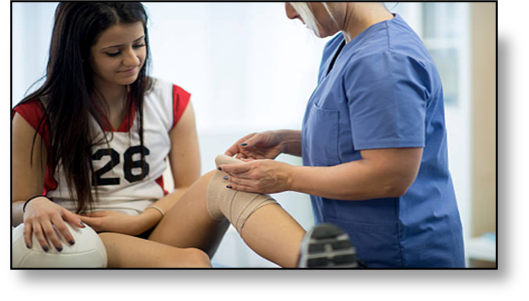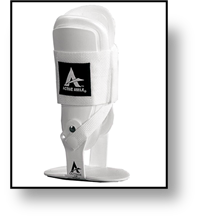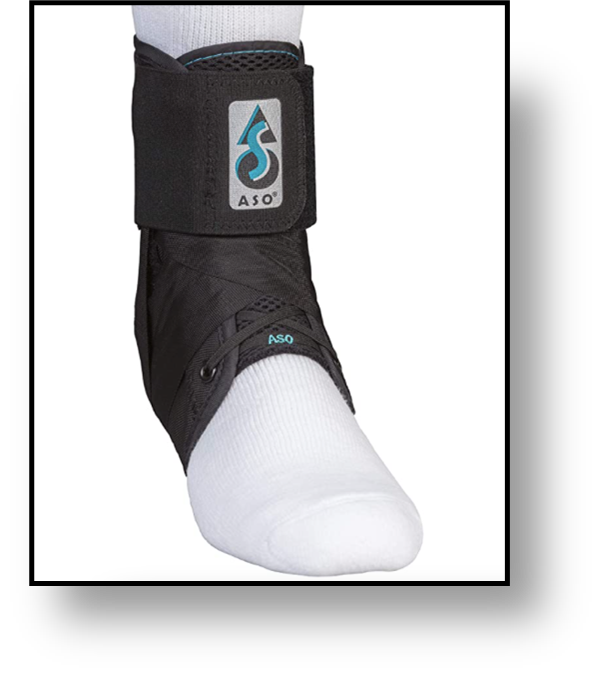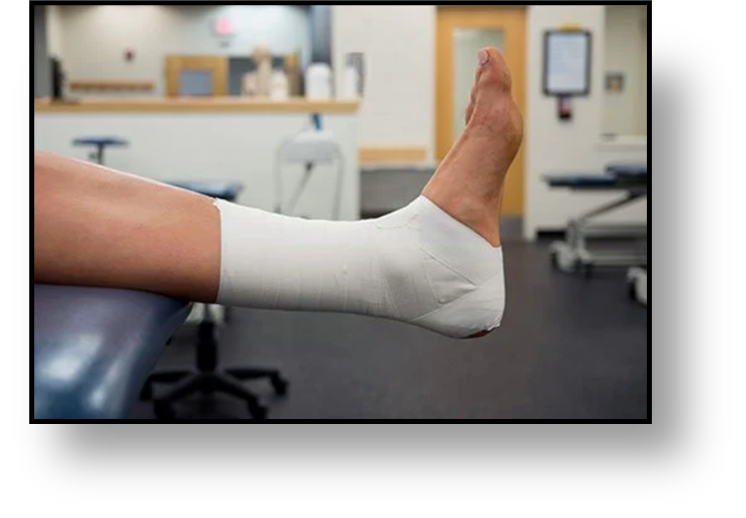09/29/2022
Taping vs Bracing
By Leah Komisak, MS, ATC, Center for Athletes Athletic Trainer
As a high school athlete, I spent a lot of time being cared for by my Athletic Trainer during basketball and soccer season. One of my most troubling injuries as a young athlete was a lateral ankle sprain that we worked tirelessly to rehabilitate and treat so that I could return to my place on the field. After a trial period of both taping and bracing my ankle (and many hours of resistance band exercises), I found that it was a lot easier to have a consistent method of support in an ankle brace than it was to get my ankle taped for practice and games.
 Unfortunately, where I grew up in Michigan, not every high school had an athletic trainer to turn to if I needed to get my ankle taped at an away game.
Unfortunately, where I grew up in Michigan, not every high school had an athletic trainer to turn to if I needed to get my ankle taped at an away game.
Being a Certified Athletic Trainer myself, I have supported athletes who needed their ankle taped before participation to feel prepared to perform at their best.
Whether you have sustained a strain or a sprain, or you want to be proactive about potential injuries, it can be challenging to decide what type of external support you need, or if you even need it at all. The basic difference between taping techniques and musculoskeletal braces are that a brace is typically going to be firm and rigid whereas tape can be more malleable and adaptive. The purpose behind each varies slightly depending on what you are protecting and why you are protecting it.
The most common regions of the body where you would find a brace or taping technique used for athletic injuries include the ankle, knee, and shoulder. For the purposes of this article, the focus will primarily be on bracing/taping techniques for the ankle.
Musculoskeletal braces are typically categorized as either prophylactic (preventative) or rehabilitative. Prophylactic braces are meant to reduce the risk of injury. Rehabilitative or functional braces are meant to allow the athlete to feel stable and supported post-injury and prevent risk of re-injury. 
Brace
To the right is an example of what a prophylactic ankle brace might look like for a volleyball player.
Some things you might notice about this brace are the lateral and medial supports and the within-shoe placement. This is a very common ankle brace worn in volleyball players who perform a lot of side-to-side movement as well as jumping and landing movements.
 A rehabilitative ankle brace might look like this:
A rehabilitative ankle brace might look like this:
You will typically see this type of brace worn by someone who is recovering from a recent ankle injury and needs additional support for daily activities.
The bonus to using a brace is that they are typically more cost-effective than using tape and can be applied by the patient themselves to their own comfort level.
Tape
Taping for the ankle differs between each sports medicine professional. Not all ankle taping techniques look the same, but they typically have the same basic principles applied to provide the appropriate amount of support and stability.
Most ankle taping techniques will include some combination of a “figure-8”, “heel lock” and “stirrups”. The “figure-8” holds the ankle joint in a neutral position. The “heel lock”, just as the name implies, locks the heel into place to keep it from moving side to side. “Stirrups” are put in place to limit excessive eversion or inversion of the ankle joint when landing. Each of these different techniques are intended to reduce the risk of an ankle sprain. You will find that some braces will also have these elements added in as additional straps.

Taping will require the hands of someone who is trained in the technique, and many athletes find increased benefit from the stability and support they feel from a solid tape job.
Precautions
There are elements of both taping and bracing that the patient should be aware of prior to application. Skin irritation can occur from taping directly to the skin, especially if someone has an allergy to adhesives. It’s also important that the tape lay as flat as possible on the body, meaning there are no creases or folds. Bracing can cause skin irritation as well in addition to discomfort if they are not fitted properly, so it’s important to make sure that the patient is sized appropriately. Sometimes this can be achieved through custom fitting versus an “off-the-shelf” model.
Strengthening and Rehabilitation
While taping and bracing are excellent methods of support during recovery, rehabilitating the area through strengthening and maintenance of range of motion will be the biggest ally to recovery and full return to activity. Bracing and taping techniques can be utilized during rehabilitation, but the end goal should be to limit the use of these external supports once strength is regained!
Footwear
A lot of ankle injuries can be prevented using appropriate footwear. When buying shoes for the next sports season, some things to take into consideration include adequate ankle support, arch support, and traction. By ensuring that you have properly fitting shoes, you can prevent injuries not just at the ankle, but the whole lower body.
About Leah Komisak, MS, ATC: Leah graduated from Central Michigan University with a  BS in Athletic Training in 2019 and went on to pursue an advanced degree in kinesiology from the University of Hawai`i. She has experience caring for athletes in collegiate sports, high school sports and military training.
BS in Athletic Training in 2019 and went on to pursue an advanced degree in kinesiology from the University of Hawai`i. She has experience caring for athletes in collegiate sports, high school sports and military training.
Leah appreciates a holistic approach in helping patients achieve their goals to return to sports while combining best practice methods and experience. She enjoys hiking, playing soccer, and reading for fun.